
 (4 / 5)
(4 / 5)
Smurfs: The Lost Village is an adventure story told so simply and with so much enthusiasm that it will definitely satisfy the younglins and more than likely break down the defences of adults.
The story opens on a recap of what Smurfs village is and the origins of Smurfette (Demi Lovato). Smurf Village is a little village where the houses are Toadstools and little blue creatures live called Smurfs, they are named after their defining characteristic i.e. Grumpy, Nosey, Baker. Smurfs can also be used as a source of raw magic if digested which is why they are hunted by the evil wizard Gargamel (Rainn Wilson), one day he created Smurfette to bring him the Smurfs, but the goodness of Papa Smurf (Mandy Patinkin) turned her good and now she lives among the others. Only weird thing though, all the other Smurfs are male. For reasons Smurfette isn’t able to find her one characteristic and is always an outsider (not just because she’s the only female). One day her and her friends Hefty (Joe Manganiello), Clumsy (Jack McBrayer) and Brainy (Danny Pudi) are wondering around and then come across another Smurf they don’t know, Gargamel also learns of this other source of Smurfs, so now the race is on for who can get there first.
The animation is loaded with energy, having the characters jump and bounce all around the screen. The character designs are an elegant translation of the old Hannah-Barbera cartoon, with minimal, but bold and expressive lines. All the Smurfs essentially look the same but they use the technique of adding something so that they instantly become recognisable i.e. glasses or a specific expression i.e. sly, grumpy and body language so that you know who’s onscreen and talking at any time.
The colour pallet is also immensely appealing. Using bright, luscious various colours to create a glowing screen. They also use blacks for more threatening moments and add contrast. Usually movies that seek to adapt a kids cartoon for a movie either make it dark in an attempt to make it appealing to older audiences, or over-saturate it with colour. This movie knows that the subject matter is by no means dark but that black, when used wisely can bring out the colour even more.

Along with all of this are some pretty neat, creative visuals. Flowers and insects that are both cute but have the right level of being threatening and the environments are sharply realised with many different textures simultaneous rendered to create a fully realised world.
One of the great strengths of the movie is a simple one to have and yet so many animated movies lack it and that is no modern-day references. Putting in modern references to any kind of social media or slang just dates the movie terribly and is nearly always forced. This movie has none of that and wont be dated because of it.
This is an adventure movie that tells it story well and with more than the necessary effort and skill gone into it. It would be something I would be more than happy to put on for my children and wouldn’t mind sitting with them for the viewing too.
Tag Archives: Review
Iphigenia in Splott, a conversation in text by Leslie R Herman Jones

This response started as a real text convo between me in NYC and Joel (JF) in our home in Adamsdown, Cardiff. It inspired me to continue in this format. Instead of commenting that the language in the play was strong, and potentially offensive to some audiences, the response enters into the spirit of the drama and uses its vernacular. The other person in this scripted response is my daughter Tillie as TJ, who attended the performance with me. – LJ.
LJ: I saw Iphigenia in Splott in NYC on Wednesday night.
JF: What was it about?
LJ: A drunken slag on Clifton St….
JF: Anyone I know?
LJ: Her world; her straight-talking shit-faced attitude.
JF: Was it set in the Clifton pharmacy getting her methadone fix?
LJ: I said a drunk not a druggie.
JF: Oh….
LJ: Her hopes, fears, delusions… how the world impacts on her and she impacts on the world…
JF: What’s her name?
LJ: Iphigenia. Effie for short.
JF: How did it go down?
LJ: New York is a pretty gritty city, you know…
JF: You would know, born and bred there.
LJ: Yes I would. So, I think they got it. Apart from a smattering of laughs in the right places (but not all the right places), Sophie Melville’s Effie silenced the house throughout with her intimidating, in-your-face performance of this real toughie from Splott, Cardiff. New Yorkers understandably missed a few laughs for which you’d really have to be there to fully appreciate. As well, some of the micro-cultural and geo-specific references may have gotten lost in translation, but overall the impact was powerful.
JF: And you knows your Caadiff, too, innit love?
LJ: Living in the ‘Diff for 35 years and off Clifton Street for ten of them ? I’ve got the T-shirt, love,… with the distinct privilege of calling The Clifton my local…
JF: We’ve seen a bit down the Clifton…
LJ: I’ve definitely avoided the likes of Effie down Clifton Street, the wounded urban warrior, bruised and battered but still standing; spitting and swearing, daring you and scaring you just by staring at you…..
JF: Yep….
LJ: Melville’s impressive performance as Effie clearly kept the audience gripped — holding on tight while she soared (Bar scene) and sank (Birthing scene) and dragged us ducking and diving through the gutter of her frenzied and high-risk out of control life.
JF: Woa! Who wrote the play?
LJ: Gary Owen.
JF: Fair play. Sounds like she did justice to the part.
LJ: She did, though she may have missed some of the nuances of the authentic Splott voice and persona that are thoroughly embedded in Owen’s script, falling just short of the highest highs and the lowest lows possible with such a tragic figure.
JF: Who directed it?
LJ: Sherman Theatre’s, Artistic Director, Rachel O’Riordan. And quite strategically. The simple set (Hayley Grindle) served this small stage. A few chairs scattered randomly, and a light fixture of fluorescent strip lights, some falling off (Lighting Designer, Rachel Mortimer) reflected a cheap and nasty flat above a shop on Clifton Street.
JF: Grunge chic…
LJ: Charting Effie’s movements across the stage was great sport — if you’re into sports and sporting analogies.
JF: Sure, I could be…
LJ: O’Riorden’s tactical staging cleverly anticipated the high points of the story by directing Effie to, say, shift a chair a number of beats beforehand, then having her double back to start a scene in order to arrive at that chair at just the right point, to score!
JF: lol
LJ: And with a pivot or a dart or a scramble across around and through the Cardiff landscape, satisfying-for-natives references to Cardiff landmarks throughout the script, O’Riordan’s use of this minimalistic set, with zero props, demanded that Melville command the space and permitted the beautifully steely script to tell the story.
JF:Sounds like you enjoyed it.
LJ: TJ cried. It was rather sad, but I didn’t cry.
JF:Why didn’t you?
LJ: I suppose it was all a bit too real. Its was so close to real life, it hurt more physically than emotionally. I ached for a while afterwards.
JF: Come back, Cardiff misses you.
LJ: I’ll be back in August.
Iphigenia in Splott played at 59E59, NYC as part of their Brits Off Broadway season, from 9 May to 4 June.
http://www.59e59.org/moreinfo.php?showid=283
Review The Importance of Being Earnest, Theatr Clwyd by Elizabeth Lambrakis
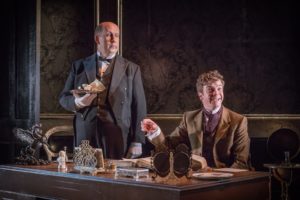
 (4 / 5)
(4 / 5)
This play is an old favourite that you may well have seen before, either on stage or on screen. So that raises certain expectations – if it’s going to be a classic production then it needs to do a lot more than just tick the boxes. Richard Fitch’s production at Theatr Clwyd certainly does just that. Yes it has the lavish period sets, and yes it has the authentically recreated Victorian costumes, but it also has a whole lot more to offer.
From the moment that Algy (James Backway) bounds onto the stage the audience is bowled along by the infectious energy of this company of 8 talented actors. No opportunity for comedy is lost as Algy and his more conventional friend Jack (Matt Jessup) engage in a verbal sparring match that only escalates when the imperious Lady Bracknell arrives with wonderfully quivering feathers in her array of impressive hats (Hilary Maclean), accompanied by her deceptively dutiful daughter Gwendolen (Emma Denly). Many of the lines are so familiar that we are almost waiting for them to be delivered, but that doesn’t make them any less funny.
And then suddenly the scenery is swept away before our eyes, and we are transported from a stuffy London townhouse to a flower-filled country garden under a blue summer’s sky. The use of a soaring Strauss waltz to accompany this scene change is inspired, and the fast pace continues as we are introduced to winsome young Cecily (Robyn Cara), her eccentric governess Miss Prism (Melanie Walters) and the pompous Reverend Chasuble (Darren Lawrence). The plot thickens with the unexpected arrivals of Algy, Jack and Gwendolen in quick succession. However the highlight of Act 2 is the vitriolic exchange of pleasantries between Cecily and Gwendolen as they mistakenly believe themselves to be engaged to the same man. A special mention should also go to Nick Harris playing contrasting butlers Lane and Merryman for creating some truly hilarious comic moments.
Before we know it the two sets of young lovers are indoors again as the last Act unfolds. Soon the mystery of Jack’s foundling origins is explained when Lady Bracknell pitches up and Miss Prism’s guilty secret is finally revealed. A happy ending is on the cards for almost everyone, with not just two but three happy couples on stage, as well as Algy and Jack turning out to be long lost brothers.
This production is a joy, richly deserving a 4 star rating, and definitely a feather in the cap of upcoming director Richard Fitch and Theatr Clwyd.
Review Running Wild, Theatre Royal Plymouth by Hannah Goslin

 (5 / 5)
(5 / 5)
Let’s start with a bold but true statement – Michael Morpurgo is one of our country’s literary geniuses. From World hits such as War Horse, from book to stage and film, Running Wild seemingly is following suit with such success and ingenious theatrical approach.
Running Wild sees the modern day tale of a young girl, on a trip with her mother to Indonesia after the death of her father, who finds herself lost in the jungle after a natural disaster and help of a beach elephant; along the way meeting new animal friends and facing terrifying situations. This tale sees the growth of her and her developing relationship with her family, both those alive and passed away as well as making bold and blunt points about human destruction of nature.
The narrative itself is well formed, in a way relatable in the sense of love and loss and pulls at your heartstrings constantly – whether this is with relation to her passing father or the bond she makes with her new animal friends. A tale that, like War Horse, has taken a lot of perfecting and trust in theatrical ability from actors to puppeteers, stage and lighting technicians to designers – the collaboration from all involved syncs this production well and seems perfect for the stage – as if Morpurgo wrote it for theatre.
Like War Horse, which coined the large puppeteering techniques used, the animals are to size and travel the stage in a very lifelike manner – the puppeteers making sounds and at times many controlling different parts of an animal, made this all seem very lifelike and by getting lost in this, you forget that the puppeteers are even there. As someone who has been up close to a real elephant, the detail and natural/lifelike nature of the animal was on point and extremely real. Obvious time and investment in the research and performance is abundant and really makes the difference for the experience.
To agree with the modern day story, Running Wild is modernised and at times takes on a ambiguous and alternative lighting, staging which creates another difference in the two productions – Running Wild is not just a carbon copy of War Horse and its techniques, but its own incredible production. The set itself gathers understanding and sense – a stage covered in random objects then compliments the natural disaster and the destruction from this that occurs. The puppeteers bringing out rectangular harsh lighting to represent the unusual environment while the girl and elephant run through the jungle and a big favourite of mine, moveable trees with fruit represented by shower luffas to add to the nature vs human element.
And finally the performers – from actors to puppeteers. Some puppeteers doubled up as actors, and some took on several characters and puppetry. To invest the performers in all elements adds to the great understanding they have with the storyline and at no point was concentration, energy or enthusiasm lost in either/all performances.
Running Wild is by far a triumph. Following in War Horse’s footsteps in some theatrical elements, there is, however, no competition; both performances are perfected and in their own right, theatrical perfection. Running Wild not only makes you well up in happiness and sadness, create shock and fear, comfort and protect you, and make severe points of modern human impressions on nature, but it manages to get you lost in the jungle with all your new animals friends.
BSL Subtitled review Romeo and Juliet, Omidaze Productions and Wales Millennium Centre Co-Production, review by Steph Back
Review National Theatre Live: Who’s Afraid of Virginia Woolf? by Danielle O’Shea
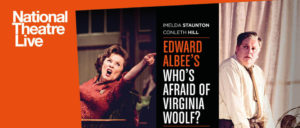
 (5 / 5)
(5 / 5)
It is difficult to say exactly what “Who’s Afraid of Virginia Woolf?” is about and that was exactly what its writer, Edward Albee, intended. Some may say it is about marriage but it tackles so much more than that including topics like politics, morality and the human condition. However, what is at the heart of the play is truth and illusion.
The play moves from illusion to truth and as the audience progresses deeper and deeper into the stories we begin to realise what is going on behind the idyllic illusion presented by each of the couples. Even today this portrayal resonates with modern audiences due to the importance placed on appearance and what we should and shouldn’t know about one another. Of course, all these boundaries fall away and soon we are left with an overwhelming tension between the characters whether this be due to anger, betrayal or desire. The claustrophobic use of the living room – the sole setting – only emphasises the isolation and confinement of each character.
Although all four cast members gave stunning performances, the audience can’t help but be drawn to Imelda Staunton as Martha, a bullying wife hiding her fragile mental state, and Conleth Hill as George, the bitter husband burdened by his failures. You cannot take your eyes of this pair whether it be during the hide-behind-your-hands low blows of their arguments or the unusual calmer moments that still wreak of hostility.
As a whole, “Who’s Afraid of Virginia Woolf?” is a classic play which resonates with all audience members because, as said in one of the pre-show interviews, what is special about this play is that it has no strict description but instead is about whatever the audience take from it. An intense performance and beautifully crafted set propels this high tension drama into nerves-inducing brilliance.
National Theatre Live: Who’s Afraid of Virginia Woolf?
Gwyn Hall, Neath
May 19th 2017
Running time: 3 hrs
Author: Edward Albee
Director: James MacDonald
Design: Tom Pye (Designer), Charles Balfour (Lighting), Adam Cork (Sound and Music), Carole Hancock (Hair, Wigs and Make-up), Amy Ball (Casting), John Haidar (Assistant Director), Bret Yount (Fights), Penny Dyer (Dialect/ Voice), Imogen Knight (Choreography).
Cast: Imelda Staunton, Conleth Hill, Imogen Poots, Luke Treadaway
Review Tell Me Anything, On The Run, The Bike Shed Theatre by Hannah Goslin

 (4 / 5)
(4 / 5)
A simplistic staging – we are greeted with a blank space, the floor filled with cylindrical tubes and in the corner, a dolphin.
Immediately this is comical and theme of comedy runs through this clever piece to counteract the raw topic. Tell Me Anything is the theatrical adaptation of David’s teenage years with his first love, who happens to have an eating disorder. This takes over their love and their relationship, as we see his side of the story. This is a new take on such a topic, seeing it through the eyes of a loved one, without the character whose disorder it is. David makes it very clear that his development of the piece isn’t without his former girlfriend, and now friend, Kate’s input and knowledge of the piece.
With mostly a true narrative, excerpts from his diary, emails and memories, it’s hard not to feel warmth in the piece and the love he had at the age of 15. Unfortunately the only thing with this is that is feels a little fairy tale; the ‘true love’ tales of conversations, feelings and interactions seem so blissful that at times it’s hard to really believe such things; the performance then feeling a little fantasy like – or maybe that is just the cynic in me talking?
David interacts with us constantly – his narration directed to us, involving us by asking us questions and also asking us to close our eyes and put ourselves in his shoes – this feels intimate and struck a chord with myself as being asked to envisage someone we love just as he describes his love for Kate, bringing up personal feelings of loss, love and all the in between.
The lovey dovey nature, soon takes comical turns when he creates satires through his energy and vocal inflections to show the silly nature of 15 year olds. And then it gets dark – his anger, his hopelessness and his pain shines through, even 14 years later it is evident on his face and in his performance. A theme throughout is that it isn’t about him, it’s about her, but this shows exactly how invested he is in his story to show both sides, without the other participant.
The lighting is simple, and it changes to flicker when anxiety and anger rises. The tubes are like a minefield, or like ‘treading on egg shells’ as he manoeuvres himself through them– the more the story deteriorates and their relationship does, the tubes and their movement by David as less controlled and begin to fall. An interesting representation of control and descent of happiness. And of course, the dolphin. The representation of being the dolphin who gently helps and nudges those in need, is brought in as support, strapped to David’s back, and later, is let out of air and crumbles as David does.
Tell Me Anything is full of theatrical symbolism, heartfelt emotion and a real life and raw story. A piece of theatre that resonates with anyone who has tried, hopelessly, to help someone they love.
https://www.bikeshedtheatre.co.uk/shows/tell-me-anything/
Review Alien Covenant by Jonathan Evans
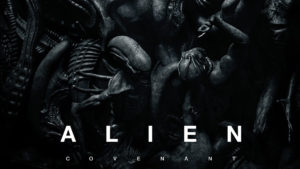
 (4 / 5)
(4 / 5)
Alien was always about the something in the dark that jumps out at you. But it masterfully crafted the art of anticipation and the jumping, as well as what it is that jumps out. Ridley Scott returned to his this world with Prometheus, which was more about the origins of us as a species rather than Alien itself. Now with this one it will definitely satisfy the people wanting the big bad creature back.
This has a lot more in-common with the other Alien movies, mostly because it’s definitely seeking to startle you in you seats. But it also comes with a few existential questions. So I guess this is a hybrid of what Scott created years ago and the questions that he wants to ask now.
The plot revolves around the spaceship Covenant, that is traveling through space to colonise another planet, a freak storm hits it and it takes a beating, the crew members wake-up but a few die. They then learn that there’s a planet nearby that could serve nicely as planet for them to settle down on. A search party lands and they find that there are things waiting for them when they arrive.
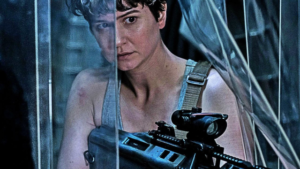
Katherine Waterson as Daniels
For the role of leading lady we have Katherine Waterson as Daniels. She does something a little different than other leading characters in an action horror. She fully displays her emotions, I don’t mean that there aren’t other examples of main characters in these types of movies having feelings, but they were more stern and gave hints of their vulnerabilities. Waterson is dealt disturbing information and one of the greatest terrors of the movies and it shows, you can see all the confusion and terror on her face but she also endures and deals with the situation knowing that she has a strong core to her. Not many people embrace so heavily showing their action stars in such a state, I applaud them for it and hope to see more.
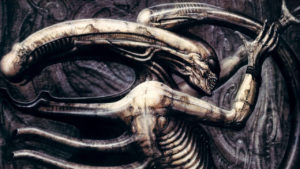
Original Xenomorph design by H.R. Giger
The Xenomorph, based on the H. R. Giger illustrations, is one of the greatest creatures ever created. It’s shape and shiny black colour makes it instantly recognisable while having intricate details close-up that makes every inch of it fascinating to take in. Whether it’s melting into the darkness, camouflaged within machinery or fully lit it is terrifying because of it’s ferocious nature and in-human body. Unlike in Prometheus, there is no ambiguity, it’s here, we see it and the characters must deal with it. It seems like it’s one-hundred-percent computer generated this time but Scott and his effects team don’t go overboard with it. They still shoot it’s scenes like they would have back then, with build-up, followed but quick shots of a slash or a burst of blood. It’s able to move faster than anyone in the suit was and they utilise that so that the threat is in it’s deadliness.
There are some images within the movie that are inspiring and thought provoking. Others that are overblown and so far beyond practical that they’ll just drawn too much attention from what happening, others where it is gruesomely terrifying.
This is Ridley Scott returning to his roots. Alien, though as masterfully made as it was, was only Scott’s second movie, since then he has gotten a lot more experienced. This shows a man who’s has years to perfect his craft and think about the subject matter to deliver a very mixed bag but comes together as a strong whole.
Whoever said that what the human mind will think of will always be more scary. That person had never seen a Xenomorph in action.
Review Joseph and the Amazing Technicolour Dreamcoat by Jane Bissett

 (4 / 5)
(4 / 5)
Joseph and the Amazing Technicolour Dreamcoat is a familiar story taken from the bible. It is the tale of a younger son, of a favoured wife, being elevated by his doting father and put above his eleven brothers. The brothers, already jealous of their younger brother finally are pushed to action and when their father Jacob gives Joseph the gift of a wonderful new coat and their outrage is complete. The brothers plot to kill Joseph and thus dispose of the problem. However, they fail to complete their plan as they cannot bring themselves to actually commit murder. The answer to this dilemma comes in the form of a travelling slave trader from Egypt and they decide to sell Joseph into slavery. On returning home the brothers tell their father, Jacob, that his beloved son has met with an accident and has been killed by a wild beast and they show him the bloody torn coat as evidence. Meanwhile Joseph has been sold into the household of an Egyptian noble where he works hard and becomes a trusted slave.
However, he catches the eye of the Noble’s wife and is soon accused of wrongdoing. His master has him thrown into prison from which there seems to be no escape. In prison Joseph becomes know for his gift of being able to know the meanings of dreams and this quickly comes to the notice of Pharaoh through his butler, a man who has first hand experience of Joseph’s ability. Joseph is summonsed to Pharaoh’s palace where he is given the task of explaining the meaning of Pharaoh’s dreams. Clearly nervous, Joseph tells Pharaoh what his recurring dream means. Egypt will have seven years of bumper harvests followed by years of famine. When the dream comes to pass Pharaoh places his trust in Joseph and puts him in high office and he becomes a trusted Egyptian. During the famine the people are starving and Joseph’s brothers come to Egypt to try to secure food for their family. The last person they expect to see is Joseph and at first they do not recognise him. Joseph doesn’t make the reunion easy but the family of brothers are eventually reconciled and reunited with Joseph’s parents, so there is a happy ending.
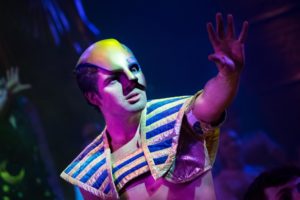
Joseph is a roller coaster ride for the theatre goer of any age. From the moment to curtain rises the production is a vibrant mix of colour and sound to stimulate the senses. From the pens of Tim Rice and Andrew Lloyd Webber, Joseph is a triumph. They have successfully taken a biblical tale and transformed it into a secular story that bridges the gaps of time and its message has as much meaning now as it had when it was written. Its appeal spans the generations and this was evident by the diversity of the audience what ever their age, gender or religious belief.

Joe McEdderry, gave a convincing and captivating performance as Joseph, his energy on stage is infectious and his smile and demeanour grabs the audience from curtain up right to the last number when he and the cast received a richly deserved standing ovation.
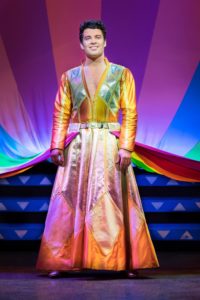
Henry Metcalfe’s choreography was creative and inspiring with many unexpected twists in the tale and lead us to expect the unexpected on several occasions. The costume design was creative and complimented the performances of the actors against a backdrop of scenery which was uncomplicated and did not distract from the telling of the story which in parts had distinctly modern twists and turns and some unexpected characterisations.
The Narrator, Lucy Kay, linked the scenes and lead the viewer on an unforgettable journey of characters, places and far away lands. With the added voices of the children it is a magical experience in which the audience is absorbed into playing an active role and ends in a well deserved standing ovation.
https://www.wmc.org.uk/Productions/2017-2018/DonaldGordonTheatre/Joseph17/
Review The North! The North! The Bike Shed Theatre by Hannah Goslin

 (3 / 5)
(3 / 5)
Entering into the underbelly of The Bike Shed Theatre, we are greeted by a solo man dancing vigorously to unidentifiable music. The North! The North! Sees the story of one man in a post-apocalyptic / alternative universe to our world as we know it. The story features a narrative that is wildly imaginative and creative, and extremely unusual. People have deformities, the world has had shortages and events during the 1970’s/1980’s that never happened in our world – essentially anything and everything is possible.
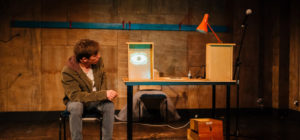
This one man show is full of energy, changes in characters which still always feel like that have a sense of the main character, adding to the strangeness of the story and is impressive with the detail from speech to action to stage and how It is all memorised.
Speaking of stage – while small, the stage is full of technological surprises. Projection is used heavily with a Mighty Boosh-esque cartoons to give place, to show props and add to the storyline. This involves being precise and well-rehearsed which he is. Each time, it brings a new joy and intrigue.

The performer himself is endearing and speaks to us like we understand this world – something so extraordinary, he does not dumb down his tale and we feel engaged and interested.
A strange but interesting production – my mother who attended said she felt as if she had ‘been involved in his own personal acid trip’ – which easily sums up this adventure.
https://www.bikeshedtheatre.co.uk/shows/the-north-the-north/


